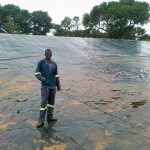HDPE Pond Liners: The Foundation for Healthy Aquatic Ecosystems
Introduction
Ponds, whether used for recreational purposes, aquaculture, or stormwater management, rely on a critical component to maintain their integrity and ensure environmental sustainability: HDPE (High-Density Polyethylene) pond liners. These impermeable barriers are the unsung heroes of ponds, ensuring water containment and preventing the loss of water, contaminants, and pollutants. In this blog, we’ll dive into the world of HDPE pond liners, exploring their applications, benefits, and their pivotal role in fostering healthy aquatic ecosystems.
Understanding HDPE Pond Liners
HDPE pond liners are synthetic membranes made from high-density polyethylene, known for their exceptional resistance to UV rays, chemicals, and physical stress. They are designed to create a watertight barrier in various pond applications, ensuring that water is securely contained within the pond, without seepage or contamination.
Applications of HDPE Pond Liners
- Recreational Ponds: These liners are used in garden ponds, koi ponds, and decorative water features, ensuring water retention and a pristine appearance.
- Aquaculture: These pond liners are essential for commercial fish farming, allowing precise control of water levels and protecting the aquatic environment from contaminants.
- Stormwater Management: Ponds are commonly used to control stormwater runoff. These pond liners ensure that collected rainwater is contained and gradually released to prevent flooding and erosion.
- Wastewater Treatment Ponds: In industrial and municipal wastewater treatment facilities, HDPE liners prevent seepage and contamination of surrounding soil and groundwater.
Benefits of HDPE Pond Liners
- Impermeability: These pond liners are designed to be impermeable, effectively preventing water seepage and protecting the environment.
- Durability: They are highly resistant to environmental factors such as UV radiation, chemicals, and temperature fluctuations, ensuring a long service life.
- Cost-Effective: Over their lifespan, these pond liners can be more cost-effective than alternative solutions, reducing the need for frequent maintenance and repairs.
- Environmental Protection: These pond liners play a crucial role in safeguarding the environment by preventing pollution and contamination of soil and groundwater.
- Customization: These liners can be tailored to the specific needs of a project, accommodating the unique size and shape requirements of ponds.
Challenges and Considerations
While thes pond liners offer numerous advantages, there are some challenges and considerations to keep in mind:
- Installation: Proper installation is critical to ensure the effectiveness of HDPE pond liners. Installation can be complex and may require experienced professionals.
- Material Selection: The choice of HDPE liner material must align with the specific needs of the project, as different materials offer varying levels of durability and chemical resistance.
- Inspection and Maintenance: Periodic inspection and maintenance are necessary to address any damage or wear and tear, especially in harsh environments.
Conclusion
HDPE pond liners are indispensable components in the creation and maintenance of healthy aquatic ecosystems, whether for recreational, aquaculture, or environmental purposes. Their impermeable nature, durability, and customization capabilities make them invaluable tools in preventing water seepage, protecting the environment, and ensuring the stability of critical infrastructure. As our world faces increasing environmental challenges, HDPE pond liners will continue to play a pivotal role in mitigating their impact and fostering sustainable aquatic ecosystems. They are a testament to the power of innovation and responsible water management in creating a greener, healthier planet.






